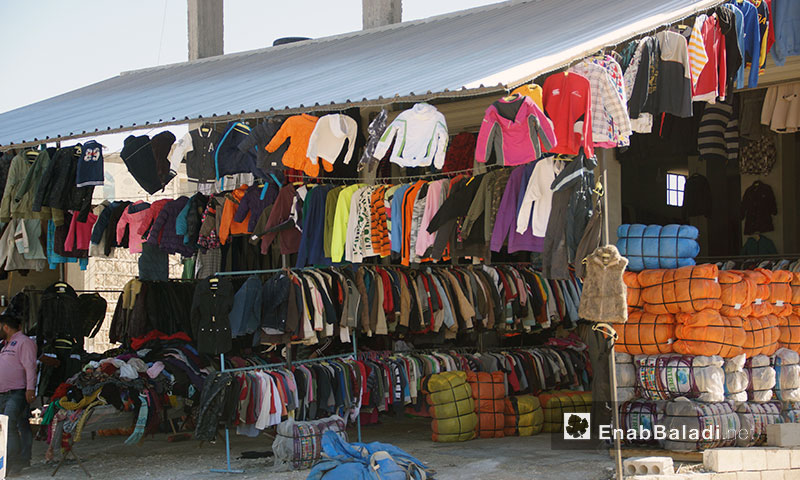



Homs – Orwah Al Mundhir
Residents of the northern countryside of Homs have resorted to new methods to secure the minimum requirements of life, including clothes for their families. Faced with the dilemma of buying clothes, the heads of households have turned to buying thrift clothes, which have become popular in recent years due to the increase in prices of new clothes.
However, the prices of thrift clothes have increased, which made it difficult for the locals to purchase, due to the fact that importing those clothes depends exclusively on foreign currencies. This obstacle paved the way for the emergence of alternative local second-hand clothes, dispensed by the region’s population.
The living conditions in Syria continue to deteriorate in conjunction with the successive collapses that beset the Syrian economy, and the instability of the exchange rate of the Syrian pound, which exceeded the barrier of 980 Syrian pounds against one US dollar for sale, and 970 to buy during the opening of the Syrian pound’s trading markets this week; hence, losing its purchasing value.
The clothing markets in Syria depend on a small number of factories and workshops distributed between the governorates of Aleppo and Damascus, which supply the local market with ready-to-wear clothes. The merchants price the clothes made in the factories, according to the exchange rate of the dollar in the black market, which contributes to rising up the prices, in a disproportionate and permanent way, in accordance with the exchange rate fluctuations.
One of the owners of the clothing stores in the Houla region, north of Homs, told Enab Baladi that the competition between ready-made clothes merchants is hindered, and the options are limited for sellers and customers, as clothes displayed in the stores are expensive and look the same, due to the decreasing number of clothing factories in post-2011 Syria.
As for the European thrift clothes, it is ultimately an imported commodity, the price of which is paid in dollars; that is why the Syrian merchants cannot continue working without rising up the prices, especially with the recent decline in the exchange rate of the Syrian pound, which prevented many traders, who used to depend on the European second-hand clothes, from buying it.
In recent months, the local thrift clothes, which are clothes that families no longer need, sold to merchants, who, in turn, sell in their stores, appeared as an alternative to European thrift and ready-made clothes.
Um Khaled, one of ar-Rastan’s locals replaces the clothes, which no longer fit her children, with new ones. Thus, with the passage of time and the accumulation of goods, it became possible to replace unfitting clothes, by paying small amounts according to the duration of owning and using the pieces by the seller.
The emergence of the local second-hand clothes deprived the poor in Syria of the surplus clothes, which were originally offered to them for free.
In November 2019, the General Establishment of Textile Industries in Syria announced that it had raised the prices of cotton fiber products by 26 percent, compared to the approved prices at the beginning of 2019.
In 2016, the Establishment issued a similar decision to increase the selling price of cotton fiber products by an estimated rate of 10 percent. Thus, the prices for a kilo of cotton yarn ranged between 750 and 909 Syrian pounds.
Moreover, the Establishment’s decision to increase the prices of cotton fiber products during the years 2016 and 2019 summarized the crises of the textile industry in Syria; i.e. to oblige the textile institution to sell cotton yarn locally at international prices, which means linking its price to the dollar exchange rate and thus increasing the price of ready-to-wear automatically.
The Syrian regime’s Ministry of Internal Trade and Consumer Protection retracted its decision to ban the import of second-hand clothes in July 2018, which was considered as a way to bridge the class gap between the rich and the poor by importing international and European clothing brands, which are not available in Syria, at competitive prices par rapport the local ready-to-wear clothes. However, this option is no longer available now to the eastern countryside of Homs and some other Syrian regions.
if you think the article contain wrong information or you have additional details Send Correction